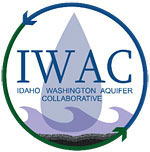Aquifer: A natural underground layer, often of sand or gravel, that contains water.
Assessment: An analysis of the susceptibility of drinking water sources to contamination, communicated effectively to the public.
Best Management Practice (BMP): A practice or combination of practices that are more effective than others for preventing or reducing contamination to the Rathdrum Prairie Aquifer.
Critical Material: Any liquid, semi-liquid, flowable or water soluble solid that is listed on the most current Superfund Amendments and Reauthorization Act, Title III List of Lists published by the U.S. Environmental Protection Agency, or is required by the U.S. Occupational Safety and Health Administration (OSHA) to have a material safety data sheet (MSDS). Critical Materials may be composed of one or more chemicals. Materials that pass fluids per the Paint Filter Test, EPA method 9095B, are considered to be liquid and flowable.
Ground Water: The water that systems pump and treat from aquifers.
Intermediate Bulk Container IBC (aka: Tote, typically 250 gallons)
Material Safety Data Sheet (MSDS): Documentation required by OSHA to describe a substanceís physical properties and hazards to human health and safety.
Non Domestic Wastewater (NDWW): Any wastewater that is not produced from typical activities in restroom facilities, showers, or kitchens.
Potential Contaminant Source: Specific point or nonpoint sources from which contamination of drinking water may originate; activities that may result in drinking water contamination.
Public Water System (PWS): Any water system which provides water to at least 25 people for at least 60 days annually. There are more than 170,000 PWSs providing water from wells, rivers and other sources to about 250 million Americans. The others drink water from private wells. There are differing standards for PWSs of different sizes and types.
Risk Ranking: Rating or prioritizing levels of concern of potential contaminant sources based on susceptibility of public water systems.
Secondary Containment: Site improvements, apparatus, and barriers that provide a second level of isolation for critical materials in order to prevent them from coming into contact with the ground surface or waters of the state. The word containment in this manual is synonymous with secondary containment.
Shallow Injection Well (SIW): A bored, dug, or drilled hole used for the disposal of fluids, usually stormwater. For rules regarding use and registration of SIWís; see IDAPA 37.03.03.
Sole Source Aquifer: A drinking water supply in an area with few or no alternative sources to the ground water resource, and where if contamination occurred, using an alternative source 45 would be extremely expensive. If such an aquifer supplies a public water system on which at least 50 percent of the population depends, it may be designated as a sole source aquifer.
Source Water Protection Area: The area delineated by the state for a public water system, or including numerous PWSs, whether the source is ground water, surface water, or both. Delineating the source water protection area is part of the state source water assessment plan approved by EPA under section 1453 of the Safe Drinking Water Act.
Standard Operating Procedure (SOP): What employees do on a regular basis to minimize release of chemical or wastewater to the ground.
Surface Water: The water that systems pump and treat from sources open to the atmosphere, such as rivers, lakes, and reservoirs.
Susceptibility: The level of risk of drinking water contamination, based on the nature and severity of contaminants, and the likelihood of the contaminants getting into a drinking water source.
Threshold Quantity: A singular or aggregate amount of critical material(s) that when met or exceeded in presence on a site, triggers mandatory compliance with rule.
Underground Injection Control Program (UIC): A program to prevent injection activities from endangering underground sources of drinking water.
Wellhead Protection Area: The surface and subsurface area surrounding a well or well field, supplying a public water system, through which contaminants are reasonably likely to move toward and reach such water well or field.



